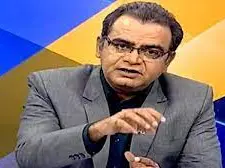Delhi : Sandeep Chaudhary, a seasoned anchor at ABP News, has become synonymous with polarizing debates through his show Seedha Sawal. Over the past three months, he has hosted over thirty debates focusing on Hindu-Muslim dynamics, with titles like “Holi vs. Ramadan: Who’s spreading hatred?” or “Aurangzeb’s tomb: A ploy for Hindu votes?” These discussions, often framed as confrontational, raise questions about whether Chaudhary is misleading his audience by amplifying communal divides for viewership or other motives.
With over two decades of experience at outlets like News24, Star News, and Doordarshan, Chaudhary has built a reputation for direct, hard-hitting journalism. Seedha Sawal promises to address viewer concerns with clarity, yet its recent focus on Hindu-Muslim issues—such as pitting festivals like Holi against Ramadan or linking historical figures to modern political strategies—suggests a deliberate choice to highlight communal tensions. This mirrors patterns seen in other media, like The Wire’s Arfa Khanum Sherwani, who produces YouTube content often criticized for similar Hindu-Muslim bias, framing issues to emphasize division over unity. Both approaches risk oversimplifying complex socio-cultural realities, potentially shaping public perception in divisive ways.
The question of whom Chaudhary is “cheating” centers on journalistic ethics. Anchors are expected to foster balanced discourse, yet Chaudhary’s debates often lean on sensationalism, framing Hindu-Muslim relations as inherently conflictual. For instance, a March 2025 debate questioned why festivals spark Hindu-Muslim disputes, ignoring their frequent coexistence in India’s diverse communities. Such framing can mislead viewers into seeing communal discord as the norm, overshadowing shared cultural practices or pressing issues like unemployment or governance, which Chaudhary addresses less frequently. This selective focus risks distorting reality, leaving audiences with a skewed understanding of India’s social fabric.
Chaudhary’s approach may reflect broader media dynamics. A 2023 claim by Congress leader Surendra Rajput noted the BJP briefly boycotted his show for posing tough questions, suggesting he doesn’t always align with one political narrative. However, his persistent choice of polarizing topics aligns with a media trend—seen in figures like Sherwani on YouTube—where communal framing drives engagement. This raises the possibility that Chaudhary’s debates prioritize channel TRPs over public interest, misleading viewers by amplifying division for ratings rather than fostering constructive dialogue.
The audience bears the brunt of this approach. By consuming content that repeatedly highlights Hindu-Muslim tensions, viewers may internalize a narrative where conflict overshadows coexistence. This can erode trust in media as a source of impartial insight, particularly when debates lack nuance or context. For example, framing Holi and Ramadan as opposing forces ignores their shared celebration in many regions, misleading viewers about the extent of communal harmony. While Chaudhary’s debates are not necessarily deceitful, they risk betraying public trust by prioritizing sensationalism over substance.
Ultimately, Chaudhary’s focus on Hindu-Muslim issues, like Sherwani’s YouTube content, may serve media agendas more than the public. By emphasizing division, he risks misleading viewers into seeing India through a lens of perpetual conflict, sidelining opportunities for unity. Responsible journalism demands balance—addressing tensions without making them the sole narrative. Until Chaudhary shifts toward more inclusive discourse, his audience may remain caught in a cycle of polarized perceptions, far from the clarity Seedha Sawal promises.





